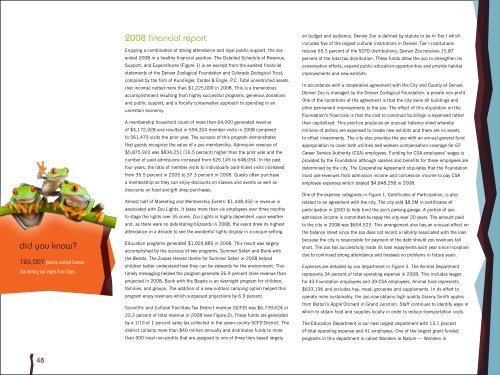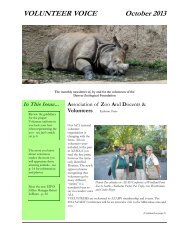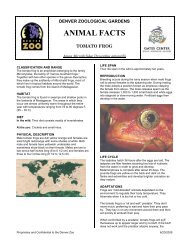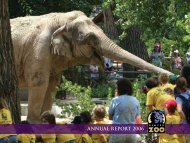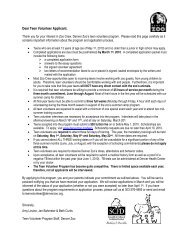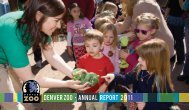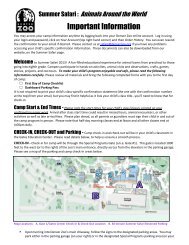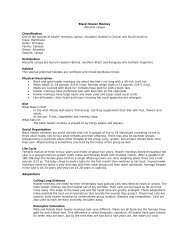2008 Annual Report - Denver Zoo
2008 Annual Report - Denver Zoo
2008 Annual Report - Denver Zoo
- No tags were found...
You also want an ePaper? Increase the reach of your titles
YUMPU automatically turns print PDFs into web optimized ePapers that Google loves.
did you know?126,007 guests visited <strong>Denver</strong><strong>Zoo</strong> during our eight Free Days.<strong>2008</strong> financial reportEnjoying a combination of strong attendance and loyal public support, the zooended <strong>2008</strong> in a healthy financial position. The Detailed Schedule of Revenue,Support, and Expenditures (Figure 1) is an excerpt from the audited financialstatements of the <strong>Denver</strong> <strong>Zoo</strong>logical Foundation and Colorado <strong>Zoo</strong>logical Trust,compiled by the firm of Kundinger, Corder & Engle, P.C. Total unrestricted assets(net income) netted more than $1,225,000 in <strong>2008</strong>. This is a tremendousaccomplishment resulting from highly successful programs, generous donationsand public support, and a fiscally conservative approach to spending in anuncertain economy.A membership household count of more than 64,000 generated revenueof $4,172,328 and resulted in 594,304 member visits in <strong>2008</strong> comparedto 561,475 visits the prior year. The success of this program demonstratesthat guests recognize the value of a zoo membership. Admission revenue of$5,875,922 was $834,251 (16.5 percent) higher than the prior year and thenumber of paid admissions increased from 626,145 to 648,054. In the pastfour years, the ratio of member visits to individually paid-ticket visits increasedfrom 35.5 percent in 2005 to 37.3 percent in <strong>2008</strong>. Guests often purchasea membership so they can enjoy discounts on classes and events as well asdiscounts on food and gift shop purchases.Almost half of Marketing and Membership Events’ $1,448,452 in revenue isassociated with <strong>Zoo</strong> Lights. It takes more than six employees over three monthsto stage the lights over 35 acres. <strong>Zoo</strong> Lights is highly dependent upon weatherand, as there were no debilitating blizzards in <strong>2008</strong>, the event drew its highestattendance in a decade to see the wonderful lights display in a unique setting.Education programs generated $1,024,885 in <strong>2008</strong>. This result was largelyaccomplished by the success of two programs, Summer Safari and Bunk withthe Beasts. The <strong>Zoo</strong>per Heroes theme for Summer Safari in <strong>2008</strong> helpedchildren better understand how they can be stewards for the environment. Thistimely messaging helped the program generate 26.9 percent more revenue thanprojected in <strong>2008</strong>. Bunk with the Beasts is an overnight program for children,families, and groups. The addition of a new outdoor camping option helped thisprogram enjoy revenues which surpassed projections by 6.9 percent.Scientific and Cultural Facilities Tax District revenue (SCFD) was $6,739,624 or22.3 percent of total revenue in <strong>2008</strong> (see Figure 2). These funds are generatedby a 1/10 of 1 percent sales tax collected in the seven-county SCFD District. Thedistrict collects more than $40 million annually and distributes funds to morethan 300 local non-profits that are assigned to one of three tiers based largelyon budget and audience. <strong>Denver</strong> <strong>Zoo</strong> is defined by statute to be in Tier I whichincludes five of the largest cultural institutions in <strong>Denver</strong>. Tier I institutionsreceive 65.5 percent of the SCFD distributions; <strong>Denver</strong> <strong>Zoo</strong> receives 15.87percent of the total tax distribution. These funds allow the zoo to strengthen itsconservation efforts, expand public education opportunities and provide habitatimprovements and new exhibits.In accordance with a cooperative agreement with the City and County of <strong>Denver</strong>,<strong>Denver</strong> <strong>Zoo</strong> is managed by the <strong>Denver</strong> <strong>Zoo</strong>logical Foundation, a private non-profit.One of the conditions of the agreement is that the city owns all buildings andother permanent improvements to the zoo. The effect of this stipulation on theFoundation’s financials is that the cost to construct buildings is expensed ratherthan capitalized. This practice produces an unusual balance sheet wherebymillions of dollars are expensed to create new exhibits and there are no assetsto offset investments. The city also provides the zoo with an annual general fundappropriation to cover both utilities and workers compensation coverage for 67Career Service Authority (CSA) employees. Funding for CSA employees’ wages isprovided by the Foundation although salaries and benefits for these employees aredetermined by the city. The Cooperative Agreement stipulates that the Foundationmust use revenues from admission income and concession income to pay CSAemployee expenses which totaled $4,848,258 in <strong>2008</strong>.One of the expense categories in Figure 1, Certificates of Participation, is alsorelated to an agreement with the city. The city sold $8.5M in certificates ofparticipation in 2000 to help fund the zoo’s parking garage. A portion of zooadmission income is committed to repay the city over 20 years. The amount paidto the city in <strong>2008</strong> was $654,523. This arrangement also has an unusual effect onthe balance sheet since the zoo does not record a liability associated with the loanbecause the city is responsible for payment of the debt should zoo revenues fallshort. The zoo has successfully made its loan repayments each year since inceptiondue to continued strong attendance and foresees no problems in future years.Expenses are detailed by zoo department in Figure 3. The Animal Departmentrepresents 24 percent of total operating expense in <strong>2008</strong>. This includes wagesfor 43 Foundation employees and 39 CSA employees. Animal food represents$633,196 and includes hay, meat, groceries and supplements. In its effort tooperate more sustainably, the zoo now obtains high quality Granny Smith applesfrom Bolton’s Apple Orchard in Grand Junction. Staff continues to identify ways inwhich to obtain food and supplies locally in order to reduce transportation costs.The Education Department is our next largest department with 13.1 percentof total operating expense and 41 employees. One of the largest grant fundedprograms in this department is called Wonders in Nature — Wonders in48


